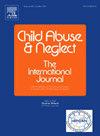威胁和剥夺经历与青少年内化和外化症状之间的关系:情绪调节和身份问题的作用。
IF 3.4
2区 心理学
Q1 FAMILY STUDIES
引用次数: 0
摘要
背景:童年逆境可以被概念化为威胁与剥夺的维度,是内化和外化症状的一个强有力的风险因素。情绪调节困难和身份问题可能是威胁和剥夺与内在化和外在化精神病理相关的两个解释变量。目的:探讨情绪调节困难和身份问题是否在儿童威胁和剥夺经历与青少年内化和外化症状之间起重要中介作用。参与者和环境:125名青少年(M = 15.33岁,77.6%为女性)从美国西南部一家精神病住院医院招募。如果符合条件,所有连续进入该单位的人都被联系参加。方法:这是一项横断面观察研究。入院时填写青少年自我报告、童年创伤问卷、情绪调节困难量表和青少年认同发展量表。测试了四个顺序中介模型。结果:较高水平的情绪调节困难和身份问题充分解释了威胁(B = 0.13, 95% CI = 0.05, 0.25)和剥夺(B = 0.23, 95% CI = 0.11, 0.38)与青少年内化症状之间的关系。然而,在检查外化症状的模型中没有观察到这些间接影响。结论:情绪调节困难和身份问题可能是将威胁和剥夺经历与后来的内化症状联系起来的合理机制,但在威胁与剥夺和外化症状之间观察到不同的关联。本文章由计算机程序翻译,如有差异,请以英文原文为准。
Associations between threat and deprivation experiences and adolescent internalizing and externalizing symptoms: The roles of emotion regulation and identity problems
Background
Childhood adversity, which can be conceptualized as dimensions of threat versus deprivation, is a robust risk factor for internalizing and externalizing symptoms. Emotion regulation difficulties and identity problems may be two explanatory variables by which threat and deprivation are linked to internalizing and externalizing psychopathology.
Objective
The present study tested whether emotion regulation difficulties and identity problems are significant mediators in associations between childhood experiences of threat and deprivation and adolescent internalizing and externalizing symptoms.
Participants and setting
125 adolescents (M = 15.33 years old, 77.6 % female) recruited from an inpatient psychiatric hospital in the Southwestern United States. All consecutive admissions to the unit were approached for participation if eligible.
Methods
This was a cross-sectional observational study. Participants completed questionnaire measures at inpatient admission including the Youth Self Report, the Childhood Trauma Questionnaire, the Difficulties in Emotion Regulation Scale, and the Assessment of Identity Development in Adolescence. Four sequential mediation models were tested.
Results
Higher levels of emotion regulation difficulties and identity problems fully explained associations between threat (B = 0.13, 95 % CI = 0.05, 0.25) and deprivation (B = 0.23, 95 % CI = 0.11, 0.38) and adolescent internalizing symptoms. However, these indirect effects were not observed in models examining externalizing symptoms. There was a direct association between deprivation and externalizing symptoms (B = 0.64, p < 0.001), but threat and externalizing symptoms were not indirectly or directly associated.
Conclusions
Emotion regulation difficulties and identity problems may be plausible mechanisms linking threat and deprivation experiences with later internalizing symptoms, but different associations were observed between threat and deprivation and externalizing symptoms.
求助全文
通过发布文献求助,成功后即可免费获取论文全文。
去求助
来源期刊

Child Abuse & Neglect
Multiple-
CiteScore
7.40
自引率
10.40%
发文量
397
期刊介绍:
Official Publication of the International Society for Prevention of Child Abuse and Neglect. Child Abuse & Neglect The International Journal, provides an international, multidisciplinary forum on all aspects of child abuse and neglect, with special emphasis on prevention and treatment; the scope extends further to all those aspects of life which either favor or hinder child development. While contributions will primarily be from the fields of psychology, psychiatry, social work, medicine, nursing, law enforcement, legislature, education, and anthropology, the Journal encourages the concerned lay individual and child-oriented advocate organizations to contribute.
 求助内容:
求助内容: 应助结果提醒方式:
应助结果提醒方式:


